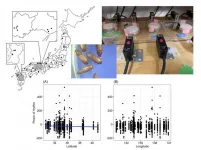(Press-News.org) A team of researchers has devised a method using smartphones in order to measure food consumption--an approach that also offers new ways to predict physical well-being.
"We've harnessed the expanding presence of mobile and smartphones around the globe to measure food consumption over time with precision and with the potential to capture seasonal shifts in diet and food consumption patterns," explains Andrew Reid Bell, an assistant professor in New York University's Department of Environmental Studies and an author of the paper, which appears in the journal Environmental Research Letters.
Food consumption has traditionally been measured by questionnaires that require respondents to recall what they ate over the previous 24 hours, to keep detailed consumption records over a three-to-four-day period, or to indicate their typical consumption patterns over one-week to one-month periods. Because these methods ask for participants to report behaviors over extended periods of time, they raise concerns about the accuracy of such documentation.
Moreover, these forms of data collection don't capture "real-time" food consumption, preventing analyses that directly link nutrition with physical activity and other measures of well-being--a notable shortcoming given the estimated two billion people in the world who are affected by moderate to severe food insecurity.
Finally, while food consumption as well as food production have a significant impact on the environment, "we do not yet have the tools to analyze food consumption in the same ways as we do for environmental variables and food production," write the study's authors, who also include Mary Killilea, a clinical professor in NYU's Department of Environmental Studies, and Mari Roberts, an NYU graduate student. "This is a critical gap, as it hampers our understanding of how environmental shocks carry through to become consumption shocks to households, communities, or regions and how responses to these shocks feed back into further environmental stress."
The team, which also included researchers from the University of Minnesota, Imperial College London, the Palli Karma-Sahayak Foundation, and Duke Kunshan University, turned to smartphones as an alternative means to track food consumption and its relationship to physical activity.
"Access to mobile devices is changing how we gather information in many ways, all the way down to the possibility of reaching respondents on their own time, on their own devices, and in their own spaces," explains Bell.
Participants included nearly 200 adults in Bangladesh who reported which among a set of general food types (e.g., nuts and seeds, oils, vegetables, leafy vegetables, fruits, meat and eggs, fish, etc.) their household had consumed in the immediately preceding 24 hours as well as which specific food items within the more general food types they had consumed (e.g., rice, wheat, barley, maize, etc.) and how much they ate. Finally, participants reported the age, gender, literacy, education level, occupation, height, and weight of each member of their household and as well as the following measures of their own physical well-being: whether they could stand up on their own after sitting down, whether they could walk for 5 kilometers (3.1 miles), and whether they could carry 20 liters (5.3 gallons) of water for 20 meters (65.6 feet). All of the information was entered by the participants on their phones using a data-collection app, with response rates as high as 90 percent.
"Food stress is dynamic, and people's needs--particularly for expectant mothers and young children--can change quickly," explains Bell. "Reaching respondents in real time allows us to map those changes in a way conventional approaches don't capture."
"Mainstreaming data collection by respondents themselves, through their own devices, would be transformative for understanding food security and for empirical social science in general," he adds. "It would mean their voices being counted through participation on their own time and terms, and not only by giving up a half-day or longer of work. For researchers, it would mean having connections to rural communities and a picture of their well-being all the time, not just when resources flow to a place in response to crisis, potentially unearthing an understanding of resilience in the face of stressors that has never before been possible."
The authors recognize concerns about smartphone availability in both rural and impoverished communities. However, they point to recent studies that show how digital technologies, such as mobile phones and satellites, have offered new ways for rural populations in developing countries to access savings, credit, and insurance.
"We now see mobile phone penetration almost everywhere in the world, with smartphone and mobile broadband subscriptions following the same trend," says Bell.
INFORMATION:
The study was supported by the Cereal Systems Initiative for South Asia (CSISA) of the Consultative Group on International Agricultural Research (CGIAR), with funding provided by the United States Agency for International Development (USAID), the Bill and Melinda Gates Foundation, the International Food Policy Research Institute, and the CGIAR Collaborative Research Program on Policies, Institutions, and Markets.
DOI: 10.1088/1748-9326/abe674
Menopause is associated with several physiological changes, including loss of skeletal muscle mass. However, the mechanisms underlying muscle wasting are not clear. A new study conducted in collaboration between the universities of Minnesota (USA) and Jyväskylä (Finland) reveals that estrogen deficiency alters the microRNA signalling in skeletal muscle, which may activate signalling cascades leading to loss of muscle mass.
Menopause leads to an estrogen deficiency that is associated with decreases in skeletal muscle mass and strength. This is likely due to changes in both muscle function and the size of muscle cells commonly referred to as fibers.
"The mechanistic role of estrogen in the loss of muscle mass had not been established. In our study, we focused on signaling cascades ...
PHILADELPHIA--A significant number of non-Hodgkin lymphoma (NHL) patients in a Penn Medicine-initiated clinical trial continue to be in remission five years after receiving the chimeric antigen receptor (CAR) T cell therapy Kymriah™, researchers in Penn's Abramson Cancer Center reported today in the END ...
Tsukuba, Japan - Scientists at the University of Tsukuba demonstrated the possibility of electrons moving as if they were massless when certain materials called "topological insulators" are irradiated with laser beams. This work may lead to a new class of highly efficient electronic devices and photonic crystals.
Conventional electronic devices rely primarily on silicon crystals. From the point of view of electrons that make up the electrical signals coursing through these materials, the systems are so big as to be practically endless. This causes most of the electronic structures ...
A unique brain protein measured in the blood could be used to diagnose Alzheimer's disease decades before symptoms develop, according to new Edith Cowan University (ECU) research.
Published in Nature journal Translational Psychiatry, the study is the first to find that people with elevated glial fibrillary acidic protein (GFAP) in the blood also have increased amyloid beta in the brain, a known indicator of Alzheimer's disease.
GFAP is a protein normally found in the brain, but it is released into the blood when the brain is damaged by early Alzheimer's disease.
Alzheimer's disease affects more than 340,000 Australians and more than 35 million people in the world. Current ...
Scientists at EMBL Heidelberg and at the Zentrum für Infektiologie at Heidelberg University Hospital have succeeded for the first time in imaging HIV during transport into the nucleus of an infected cell. The electron tomographic images show the protein envelope of the virus passing through one of the nuclear pores - the openings in the membrane around the nucleus that allow molecules in and out. The scientists found that the virus passes through the nuclear pore intact, only breaking apart inside the nucleus, where it releases its genetic information. This clarifies an important mechanism by which the virus's genetic material is integrated into the genome of the infected cell.
The human immunodeficiency virus type 1 (HIV-1) - which was ...
A highly porous metal organic framework, assembled from molecular building blocks designed to lock together in a specific orientation, has been developed by researchers at KAUST.
Metal organic frameworks (MOFs) are crystalline materials made from metal ions connected by organic linkers. Their internal structure is like a repeating array of tiny identical cages, which are ideal for hosting various molecules. MOFs have found potential uses from gas sensing to molecular separations to storage, depending on the dimensions and structure of their pores.
One family of MOFs has been inspired by inorganic porous materials called zeolites. Zeolites are a special class of porous material with ...
One of the most intriguing features in all living beings is the "biological clock", an internal time-keeping mechanism that governs our behavioral pattern (such as the sleep-wake cycle). In fact, the biological clock dictates the developmental timing of various processes, such as when flowers bloom and insects reproduce. Biologists refer to these activities collectively as "circadian rhythms," owing to the rhythmic pattern in which they occur.
Since their discovery, circadian rhythms have been studied extensively, and today we know a great deal about how they work. ...
When women undergo surgical treatment for breast cancer, they often also have reconstructive surgery but new QUT research reveals many women feel left out of the decision making.
An interdisciplinary study from researchers in QUT's Centre for Behavioural Economics, Society and Technology (BEST), Engineering Faculty, and School of Nursing, along with Dr Jeremy Hunt a Fellow of the Royal Australasian College of Surgeons and Dr Tim Peltz from the University of New South Wales, on Knowledge, consultation time and choice in breast reconstruction has just been published in the British Journal of Surgery.
"Approximately one in seven Australian women will be diagnosed with breast cancer in their lifetime," ...
Most Chinese working in the cities return to work today after a 7-day public holiday of Spring Festival. The annual Spring Festival, which also marks the start of Chinese New Year, traditionally begins with the second new moon following the winter solstice, usually in January or February. Like westerners on Thanksgiving and Christmas, people across China return to their hometown to reunite with family and friends. However, the sudden outbreak of COVID-19 last year halted the largest holiday mobilization in the world. In response to the crisis, in late 2019, local governments launched ...
After nearly a decade of research, a new test that detects the magnetic properties of malaria-infected blood could soon be used to help eliminate the mosquito-borne disease.
Dr Stephan Karl, a Senior Research Fellow in Malaria and Vector Biology at James Cook University's Australian Institute of Tropical Health and Medicine, has led an international study to field-test a new tool in the fight to eliminate the disease, which had 229 million reported cases in 2019.
"Malaria is easily treated but it is actually hard to diagnose, and because of that there ...


